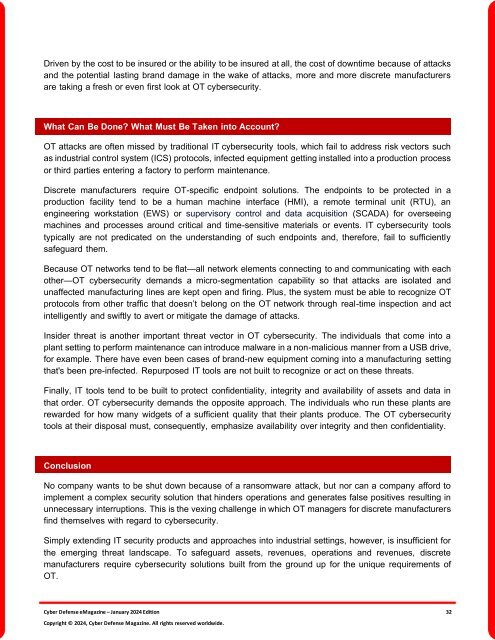The Cyber Defense eMagazine January Edition for 2024
Cyber Defense eMagazine January Edition for 2024 #CDM #CYBERDEFENSEMAG @CyberDefenseMag by @Miliefsky a world-renowned cyber security expert and the Publisher of Cyber Defense Magazine as part of the Cyber Defense Media Group as well as Yan Ross, Editor-in-Chief and many more writers, partners and supporters who make this an awesome publication! 201 page January Edition fully packed with some of our best content. Thank you all and to our readers! OSINT ROCKS! #CDM #CDMG #OSINT #CYBERSECURITY #INFOSEC #BEST #PRACTICES #TIPS #TECHNIQUES
Cyber Defense eMagazine January Edition for 2024 #CDM #CYBERDEFENSEMAG @CyberDefenseMag by @Miliefsky a world-renowned cyber security expert and the Publisher of Cyber Defense Magazine as part of the Cyber Defense Media Group as well as Yan Ross, Editor-in-Chief and many more writers, partners and supporters who make this an awesome publication! 201 page January Edition fully packed with some of our best content. Thank you all and to our readers! OSINT ROCKS! #CDM #CDMG #OSINT #CYBERSECURITY #INFOSEC #BEST #PRACTICES #TIPS #TECHNIQUES
Create successful ePaper yourself
Turn your PDF publications into a flip-book with our unique Google optimized e-Paper software.
Driven by the cost to be insured or the ability to be insured at all, the cost of downtime because of attacks<br />
and the potential lasting brand damage in the wake of attacks, more and more discrete manufacturers<br />
are taking a fresh or even first look at OT cybersecurity.<br />
What Can Be Done? What Must Be Taken into Account?<br />
OT attacks are often missed by traditional IT cybersecurity tools, which fail to address risk vectors such<br />
as industrial control system (ICS) protocols, infected equipment getting installed into a production process<br />
or third parties entering a factory to per<strong>for</strong>m maintenance.<br />
Discrete manufacturers require OT-specific endpoint solutions. <strong>The</strong> endpoints to be protected in a<br />
production facility tend to be a human machine interface (HMI), a remote terminal unit (RTU), an<br />
engineering workstation (EWS) or supervisory control and data acquisition (SCADA) <strong>for</strong> overseeing<br />
machines and processes around critical and time-sensitive materials or events. IT cybersecurity tools<br />
typically are not predicated on the understanding of such endpoints and, there<strong>for</strong>e, fail to sufficiently<br />
safeguard them.<br />
Because OT networks tend to be flat—all network elements connecting to and communicating with each<br />
other—OT cybersecurity demands a micro-segmentation capability so that attacks are isolated and<br />
unaffected manufacturing lines are kept open and firing. Plus, the system must be able to recognize OT<br />
protocols from other traffic that doesn’t belong on the OT network through real-time inspection and act<br />
intelligently and swiftly to avert or mitigate the damage of attacks.<br />
Insider threat is another important threat vector in OT cybersecurity. <strong>The</strong> individuals that come into a<br />
plant setting to per<strong>for</strong>m maintenance can introduce malware in a non-malicious manner from a USB drive,<br />
<strong>for</strong> example. <strong>The</strong>re have even been cases of brand-new equipment coming into a manufacturing setting<br />
that's been pre-infected. Repurposed IT tools are not built to recognize or act on these threats.<br />
Finally, IT tools tend to be built to protect confidentiality, integrity and availability of assets and data in<br />
that order. OT cybersecurity demands the opposite approach. <strong>The</strong> individuals who run these plants are<br />
rewarded <strong>for</strong> how many widgets of a sufficient quality that their plants produce. <strong>The</strong> OT cybersecurity<br />
tools at their disposal must, consequently, emphasize availability over integrity and then confidentiality.<br />
Conclusion<br />
No company wants to be shut down because of a ransomware attack, but nor can a company af<strong>for</strong>d to<br />
implement a complex security solution that hinders operations and generates false positives resulting in<br />
unnecessary interruptions. This is the vexing challenge in which OT managers <strong>for</strong> discrete manufacturers<br />
find themselves with regard to cybersecurity.<br />
Simply extending IT security products and approaches into industrial settings, however, is insufficient <strong>for</strong><br />
the emerging threat landscape. To safeguard assets, revenues, operations and revenues, discrete<br />
manufacturers require cybersecurity solutions built from the ground up <strong>for</strong> the unique requirements of<br />
OT.<br />
<strong>Cyber</strong> <strong>Defense</strong> <strong>eMagazine</strong> – <strong>January</strong> <strong>2024</strong> <strong>Edition</strong> 32<br />
Copyright © <strong>2024</strong>, <strong>Cyber</strong> <strong>Defense</strong> Magazine. All rights reserved worldwide.

















